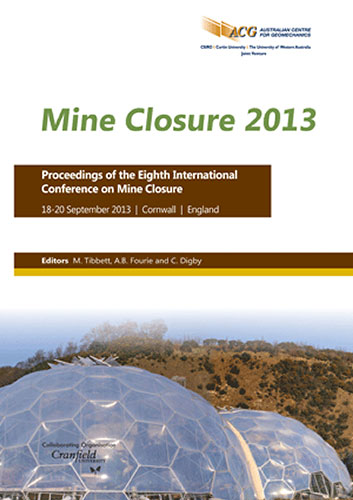Risk assessment of geological environment and closure plan of Heshan coal mine, southwest China

|
Authors: Tang, ZH; Zhang, H; Zhou, CX; Zhang, H; Zhou, JW Paper is not available for download Contact Us |
DOI https://doi.org/10.36487/ACG_rep/1352_46_Tang
Cite As:
Tang, ZH, Zhang, H, Zhou, CX, Zhang, H & Zhou, JW 2013, 'Risk assessment of geological environment and closure plan of Heshan coal mine, southwest China', in M Tibbett, AB Fourie & C Digby (eds), Mine Closure 2013: Proceedings of the Eighth International Seminar on Mine Closure, Australian Centre for Geomechanics, Cornwall, pp. 547-556, https://doi.org/10.36487/ACG_rep/1352_46_Tang
Abstract:
Heshan, a city located in Guangxi Autonomous Region, southwest China, is built over an old coal mining area. With the exhaustion of coal resources, the city is faced with economic transformation and increasing construction, which cries for risk assessment and a closure plan of its coal mine operations. Risk assessment of the mine’s geological environment consists of two steps, with the first one to assess the risk from mining and the second to evaluate the risk to city development. The mining risk to geological environment is from the mine’s geological conditions, mining status and geo-environmental problems related to mining. Nine factors are considered in the risk assessment: landform, vegetation cover, engineering petrofabric, mine density, coal tilt angle, the ratio of mining depth and thickness of coal seam, land resources damage, water resources damage and geological hazards. Based on the assessment, the paper proposes the closure plan of the Hehan coal mine. The Heshan coal mine is divided into a high-risk area with 62.87 km2, a medium-risk area with 118.84 km2 and a low-risk area with 175.99 km2. The closure plan is divided into three stages according to risk level. The first stage is to manage the high-risk area and to develop a national mine park, which includes Lilan mine, Dongkuang mine, Shangtang mine and Suhe mine. Those mines mainly handle three large waste dumps, as well as many small waste dumps and abandoned mines. Ecological improvement projects include flattening slopes, retaining walls, earth covering, etc. Drainage and revegetation are designed to transform large waste dumps into eco-greenbelts and sight spots. In Lilan and Dongkuan, some complete mines and buildings are being preserved as historical industrial viewing spots once recovery and revegetation are completed. This paper indicates that risk assessment and closure plans are reliable guidance for the management of the mining risk to the geological environment in Heshan city.
References:
Aleotti, P. and Chowdhury, R. (1999) Landslide hazard assessment: summary review and new perspectives, Bulletin of Engineering Geology and the Environment, Vol. 58, pp. 21–44.
Fourie, A.B. and Brent, A.C. (2006) A project-based mine closure model (MCM) for sustainable asset life cycle management, Journal of Cleaner Production, Vol. 14, pp. 1085–1095.
Wu, Q. and Chen, Q. (2010) An analysis of the mine environmental treatment model and its applicability (in Chinese), Hydrogeology & Engineering Geology, Vol. 37(5), pp. 91–96.
Xu, Y.N., He, F., Yuan, H.C., Zhang, J.H. and Chen, S.B.(2006) Survey and Assessment on Environmental Geology Problems of Mine in Northwest China (in Chinese), Geology Press, Beijing, China.
Zhou, A.G. and Cai, H.S. (1988) Geological Environmental Quality Assessment Theory and Application (in Chinese), China University of Geosciences Press, Wuhan, China.
© Copyright 2025, Australian Centre for Geomechanics (ACG), The University of Western Australia. All rights reserved.
View copyright/legal information
Please direct any queries or error reports to repository-acg@uwa.edu.au
View copyright/legal information
Please direct any queries or error reports to repository-acg@uwa.edu.au